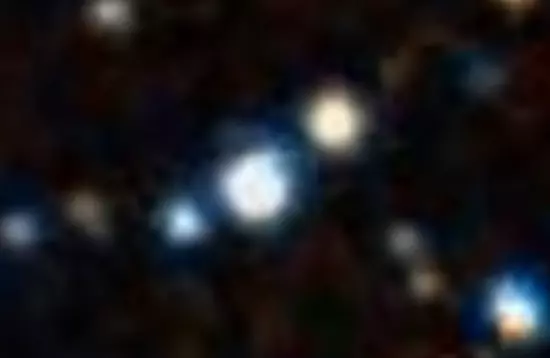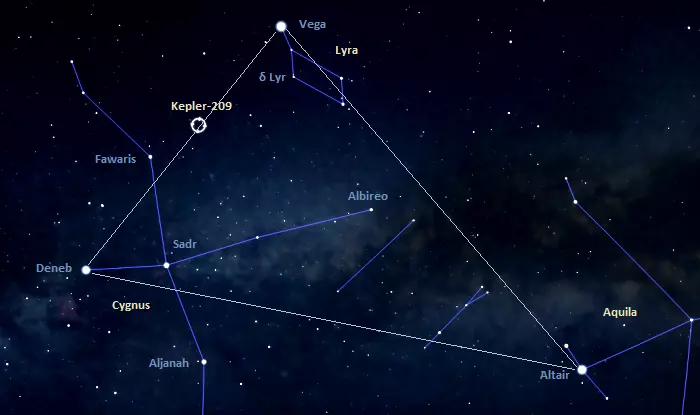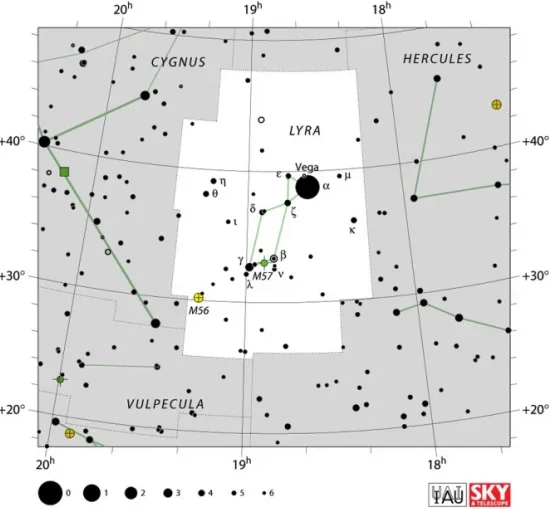Kepler-209 is a yellow G7-type star located at an estimated distance of 1,895 light-years in the constellation Lyra. With an apparent magnitude of 12.80, the star is invisible to the unaided eye. It hosts two extrasolar planets, Kepler-209 b and Kepler-209 c, discovered in 2014.
Star type
Kepler-209 is a yellow dwarf of the spectral type G7V. It has a mass of 0.95 solar masses and a radius 92% that of the Sun. The estimated age of the star is between 1.95 and 7.77 billion years.
The Simbad Astronomical Database lists Kepler-209 as a rotating variable star. Rotating variables vary in brightness due to irregular surface brightness coupled with the effects of rotation.
The Neptune-like exoplanets Kepler-209 b and Kepler-209 c were discovered orbiting the star in 2014.

Kepler-209, image credit: Wikisky
Planets
Kepler-209 hosts two gas giant planets, Kepler-209 b and Kepler-209 c. Both were discovered using the transit method. The planets were validated by a team of scientists led by Jason F. Rowe at the NASA Ames Research Center in a study published in The Astrophysical Journal on March 4, 2014.
Kepler-209 b is a Neptune-like gas giant planet that orbits the parent star with a period of 16.09 days at a separation of 0.122 astronomical units. It has a mass of 5.73 Earth masses and a radius of 0.202 Jupiter radii.
The more distant planet Kepler-209 c orbits the host star with a period of 41.7 days at a distance of 0.231 astronomical units. The planet has a mass of 9.8 Earth masses and a radius of 0.277 Jupiter radii.
Neither planet orbits in the star’s habitable zone, which is located at a distance between 0.619 and 1.304 astronomical units from the star. The habitable zone of a star is defined as the distance from the star at which it is possible for liquid water to exist on a planet’s surface. Kepler-209 b and Kepler-209 c are too close to Kepler-209 for liquid water to form on their surfaces and are therefore unlikely to be habitable.
A third planet, KOI-672.03, was detected in the system at the same time as the other two, but it turned out to be a false-positive candidate.
Name
The star Kepler-209 does not have a proper name. It was discovered as part of the NASA Kepler mission, which aimed at finding planets outside the solar system, with a focus on terrestrial Earth-size planets in the habitable zone of the stars they were orbiting.
The Kepler space telescope did not observe the entire sky. It focused on a part of the sky in the constellations Cygnus, Draco, and Lyra, and detected an exorbitant number of extrasolar planets over the course of its 9-year mission. The telescope was retired in 2018 because it did not have enough fuel to continue the mission.
Kepler’s survey and exoplanet discoveries have made huge advances in all areas of planetary science and astrophysics. Kepler’s legacy is the most detailed catalog of exoplanet candidates in a single portion of the sky.
Kepler was succeeded by two space telescopes, the Transiting Exoplanet Survey Satellite (TESS) and the James Webb Space Telescope (JWST).
Kepler-209 is catalogued as KOI 672 in the Kepler Objects of Interest (KOI) catalog, the final catalog of planet candidates discovered by the Kepler telescope.
Facts
The Kepler spacecraft was launched by NASA in 2009 to detect Earth-sized planets in or near the habitable zones of their parent stars, with a focus on solar-type stars. It did so by identifying stars with periods of transit-like signatures, which suggested the presence of transiting planets or eclipsing binary systems. The slight dimming of light was recorded when planets passed in front of their parent stars. By the time of its retirement, the telescope discovered a total of 2,662 exoplanets after observing 530,506 stars.
The space telescope was named after the German astronomer Johannes Kepler, best known for describing the orbits of planets around the Sun (Kepler’s laws of planetary motion) in the early 17th century.
Location
Kepler-209 lies under the wing of the celestial Swan (Cygnus), but it is part of the Lyra constellation. The star appears a little more than halfway from Deneb to Vega, in the region between Fawaris and Delta Lyrae. The barred spiral galaxy NGC 6792 lies in the same area of the sky.
Deneb and Vega form the Summer Triangle with Altair, the brightest star in Aquila. Each star is quite easy to identify. Deneb sits at the top of the Northern Cross, a prominent asterism visible high overhead during the northern hemisphere summer. Altair is flanked by two relatively bright stars, Tarazed and Alshain, and Vega appears near a fainter parallelogram that outlines the celestial Harp.

The location of Kepler-209, image: Stellarium
Constellation
Kepler-209 is located in the constellation Lyra. The Harp is one of the Greek constellations, catalogued by the Greek astronomer Ptolemy in the 2nd century CE. In Greek mythology, it is associated with the lyre of Orpheus, a tragic poet and musician. In ancient lore, Orpheus met his end at the hands of the Bacchantes and his lyre was tossed into a river. The god Zeus sent his eagle to fetch the instrument and placed both Orpheus and his lyre in the sky.
Lyra is quite small. It occupies an area of 286 square degrees of the northern sky and is the 52nd constellation in size out of 88. It appears near the larger constellations Hercules and Cygnus.

Lyra constellation map by IAU and Sky&Telescope magazine
Despite its size, Lyra is easily recognizable. Vega, its brightest star, is the fifth brightest star in the sky. It appears next to a small parallelogram of fainter stars that form the lyre of Orpheus.
Other notable stars in Lyra are the multiple star system Beta Lyrae (Sheliak), which serves as the prototype for a class of stars known as the Beta Lyrae variables, the multiple star system Epsilon Lyrae, popularly known as the Double Double, the pulsating variable class prototype RR Lyrae, and the variable bright giant Delta2 Lyrae.
Lyra also hosts several well-known deep sky objects. These include the planetary nebulae Messier 57, also known as the Ring Nebula, and Abell 46, the globular star cluster Messier 56, the open cluster NGC 6791, and the irregular galaxy NGC 6745.
The best time of the year to observe the stars and deep sky objects in Lyra is during the month of August, when the constellation is high above the horizon in the evening sky. The entire constellation is visible from locations north of the latitude 40° S.
The 10 brightest stars in Lyra are Vega (Alpha Lyrae, mag. 0.026), Sulafat (Gamma Lyrae, mag. 3.261), Sheliak (Beta Lyrae A, mag. 3.52), R Lyrae (mag. 4.00), Delta2 Lyrae (mag. 4.22), Kappa Lyrae (mag. 4.35), Zeta1 Lyrae (mag. 4.34), Theta Lyrae (mag. 4.347), Aladfar (Eta Lyrae, mag. 4.40), and Epsilon2 Lyrae A (mag. 4.59).
Kepler-209
| Spectral class | G7V |
| Apparent magnitude | 12.80 |
| Absolute magnitude | 3.95 |
| Distance | 1,895 light-years (580.9786 parsecs) |
| Parallax | 1.7094 ± 0.0129 mas |
| Radial velocity | -12.25 ± 3.42 km/s |
| Proper motion | RA: -10.114 ± 0.015 |
| Dec.: -17.919 ± 0.018 | |
| Mass | 0.95 M☉ |
| Luminosity | 0.691 L☉ (Gaia DR2) |
| Radius | 0.92 R☉ |
| Temperature | 5,564 K |
| Metallicity [Fe/H] | 0.008 |
| Age | 4.47 billion years (1.95 – 7.77 billion years) |
| Surface gravity | 4.4329 cm/s2 |
| Constellation | Lyra |
| Right ascension | 19h 24m 40.6838040491s |
| Declination | +42° 38′ 26.899016407″ |
| Names and designations | Kepler-209, 2MASS J19244068+4238269, AP J19244068+4238269, KIC 7115785, KOI-672, SPOCS 3658, TIC 159652365, Gaia DR2 2101964558106974848, Gaia DR3 2101964558106974848 |